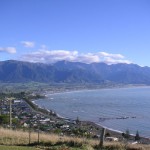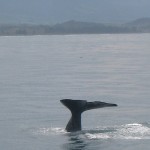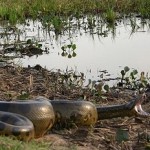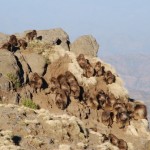KAIKOURA, New Zealand: Whale Watching, Dolphin Encounters & Crayfish
Posted by: kirsty_wilson in Australasia, tags: Marine life, Mountains, New Zealand, Outdoor Activities, WildlifeWhere is Kaikoura?

View over Kaikoura
Kaikoura is located at the top of the east coast of the South Island of New Zealand. A small township with a population of only 3,000 people, it draws around 900,000 tourists a year because of resident giant sperm whales and up to seven other species of whale which come to feed in the deep waters off the coast.
Angela Pearse spent three days in Kaikoura and had her own up close and personal whale experience.
“Our first sperrrrrm whale coming up ladies and gentlemen!”, shouts Jim our onboard commentator, and general funny man, for the two and a half hour whale watching experience.
Up until now we’ve been motoring at a steady pace from shore but suddenly the boat shoots off, rocking alarmingly up and down on the two metre swell. When checking in with Whale Watch Kaikoura [www.whalewatch.co.nz] there was a sea-sickness warning but I came prepared with my ‘Ease the Quease’ pills which I dutifully took before even setting foot on the boat. I have a weak stomach at the best of times.
A fellow passenger lets the waves get the better of her and throws up gracefully into a complimentary paper bag. I’m sympathetic but with cries of “We’re chasing a whale, ladies and gentlemen,” from Jim, there’s no time to waste being sick.
We all pile over to starboard (“If you’re on the left, you’re on the wrrrronnng side”, drawls Jim). And wait and wait. The captain turns off the motor and we galoop up and down on the swelling sea. Nothing. The whale has already dived and is now feeding somewhere up to three kilometres beneath us. “It could be down there for up to two hours,” says Jim, “We lost that race. But not to worry, the captain is going to listen to see if there are any other whales around”. A handy whale listening device is hastily produced which looks like a long bendy bit of plastic tubing with a funnel duct-taped to the end. The captain listens intently to whale noises which apparently sound like trying to start your car with a flat battery.

Whale watching
We take off again. Jim tells us that all the whales in the area are male as the water is too cold for the breeding females. The females are all (rather cleverly, I think) in the Bahamas. Some of the whales which we will encounter, like Manu, are resident and stay in Kaikoura all year round.
Soon enough we see our first whale, blowing and snorting up ahead. “Our first encounter, ladies and gentlemen, fantastic!” says Jim voicing our enthusiasm for us. But it is thrilling to see a whale close up, it looks like a large floating black log. But we are only seeing the tip of the iceberg, the very top of the whale’s head, the rest of the huge mammal is submerged somewhere beneath the waves.
“We don’t know how long he’s been up, he could go at any minute”, says Jim cheerfully, making us grab for our cameras. No pressure, I think. Sure enough the whale lies there for a bit then arches its back taking a last breath. “Cameras ready people”, calls Jim, “He’s about to dive!”. Sure enough the whale ducks down and its tail flicks gracefully up into the air. You could have heard a pin drop (apart
from the clicking of cameras). We are hooked. We want more whales and Jim knows it. We set out on the hunt once again with all of us hanging on for dear life as the boat powers off.
The experienced crew seem easily able to spot the whales from a long distance, and in total we see five sperm whales. But on the way back into shore Jim says he has a surprise treat for us. A sixth whale, a rare Southern Right is in the area.
We all pile outside again as the boat plies patiently up and down the shoreline in search of the whale. “Over to starboard mate”, says one of the crew. After a few seconds a black hump and a tell-tale waterspout emerges on the slate grey horizon. “This whale’s behaviour is slightly different”, Jim tells us. True enough, it doesn’t lie on top of the sea and flick its tail but duck dives smoothly beside the boat as we putt alongside like its anxious child.
We gaze in mesmerised awe until Jim says it’s time to leave the whale to continue feeding. Though I doubt any whales had actually stopped feeding for a minute because of our presence. They probably
never even noticed we were there.
Jim plays us a series of videos on the trip back to shore which show typical whale behaviour, such as tail thumping and jaw clacking. In one of them called ‘The Encounter’ a determined whale tries to make contact with the boat. On second thoughts, I consider, perhaps it is best to leave them feeding in peace.
The Complete Whale-Watching Handbook: A Guide to Whales, Dolphins, and Porpoises of the World
Map
TravelTipsPlus Google Map of Kaikoura
One Great Reason to Visit Kaikoura
One great reason to visit this travel destination is for an up close and personal experience with majestic sperm whales.
Magic of Kaikoura
For More Information
You Might Also Enjoy The Following Travel Destinations





 Entries (RSS)
Entries (RSS)